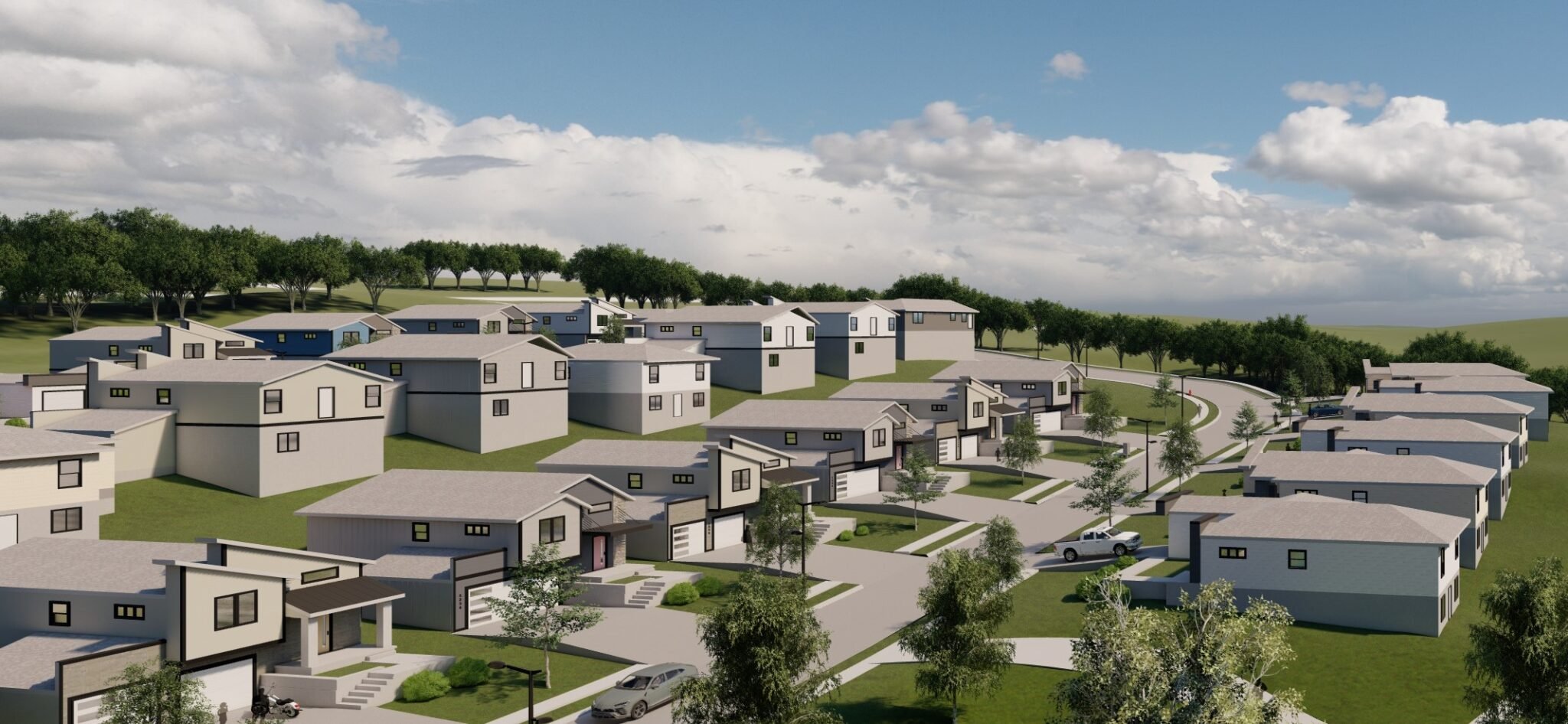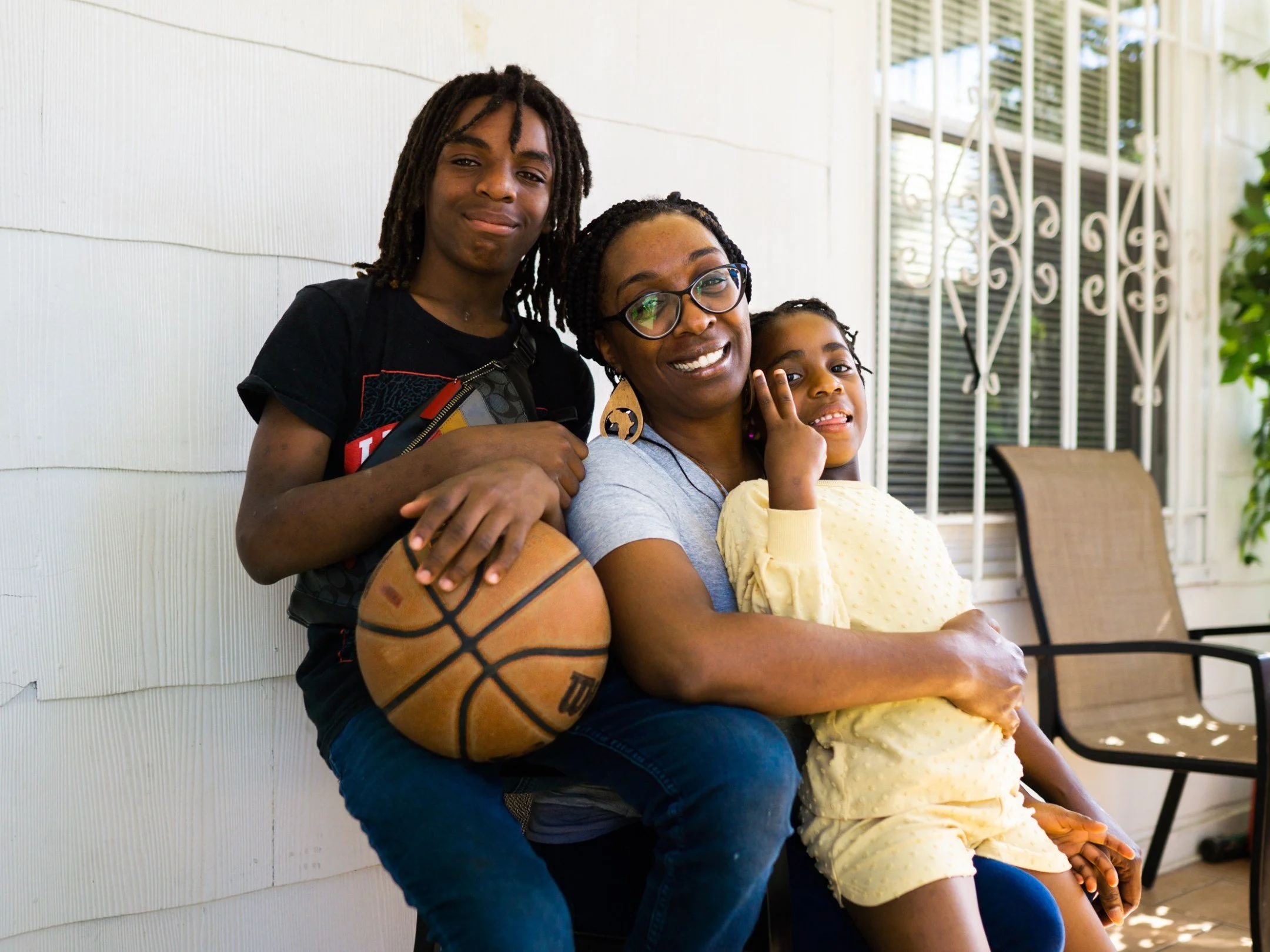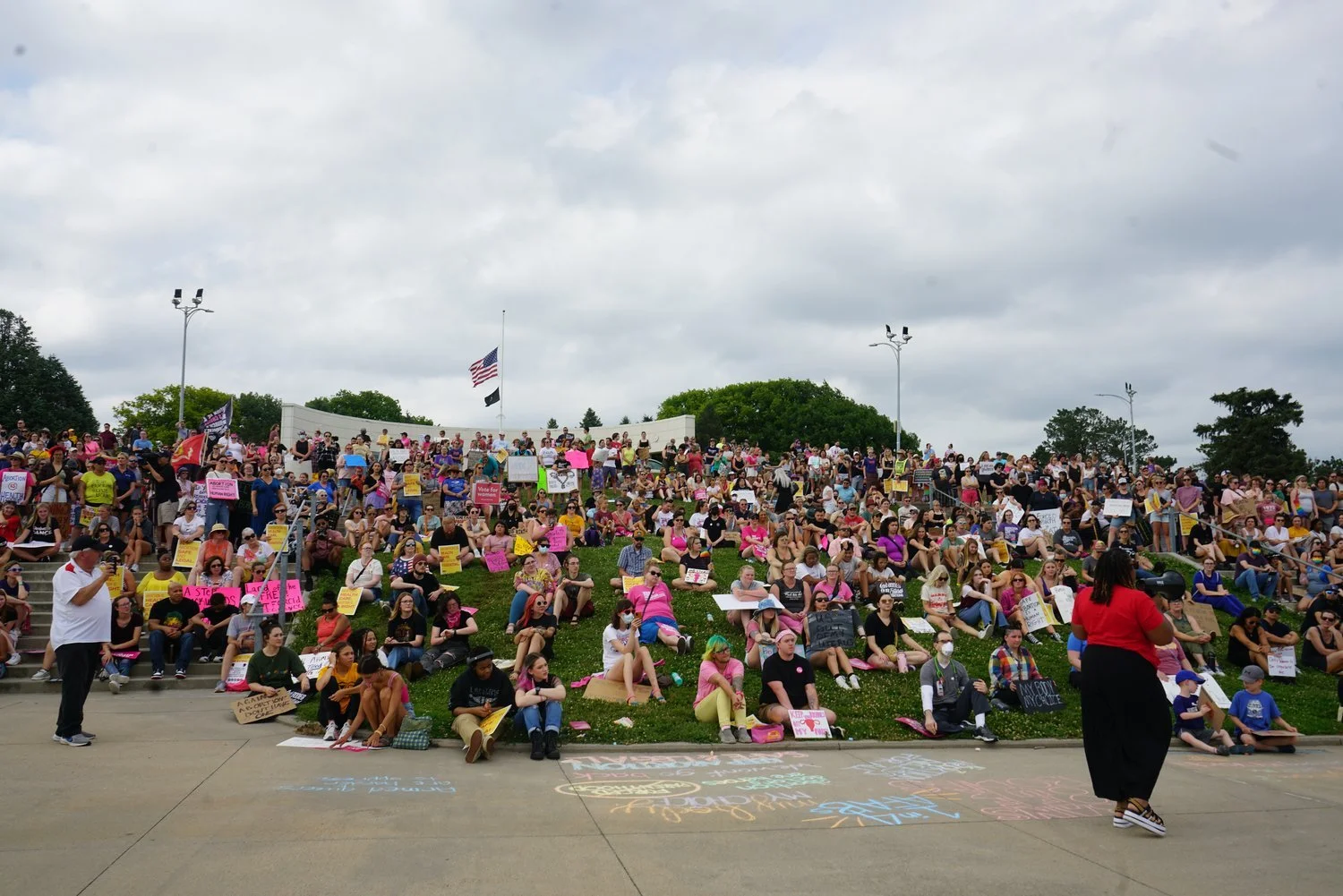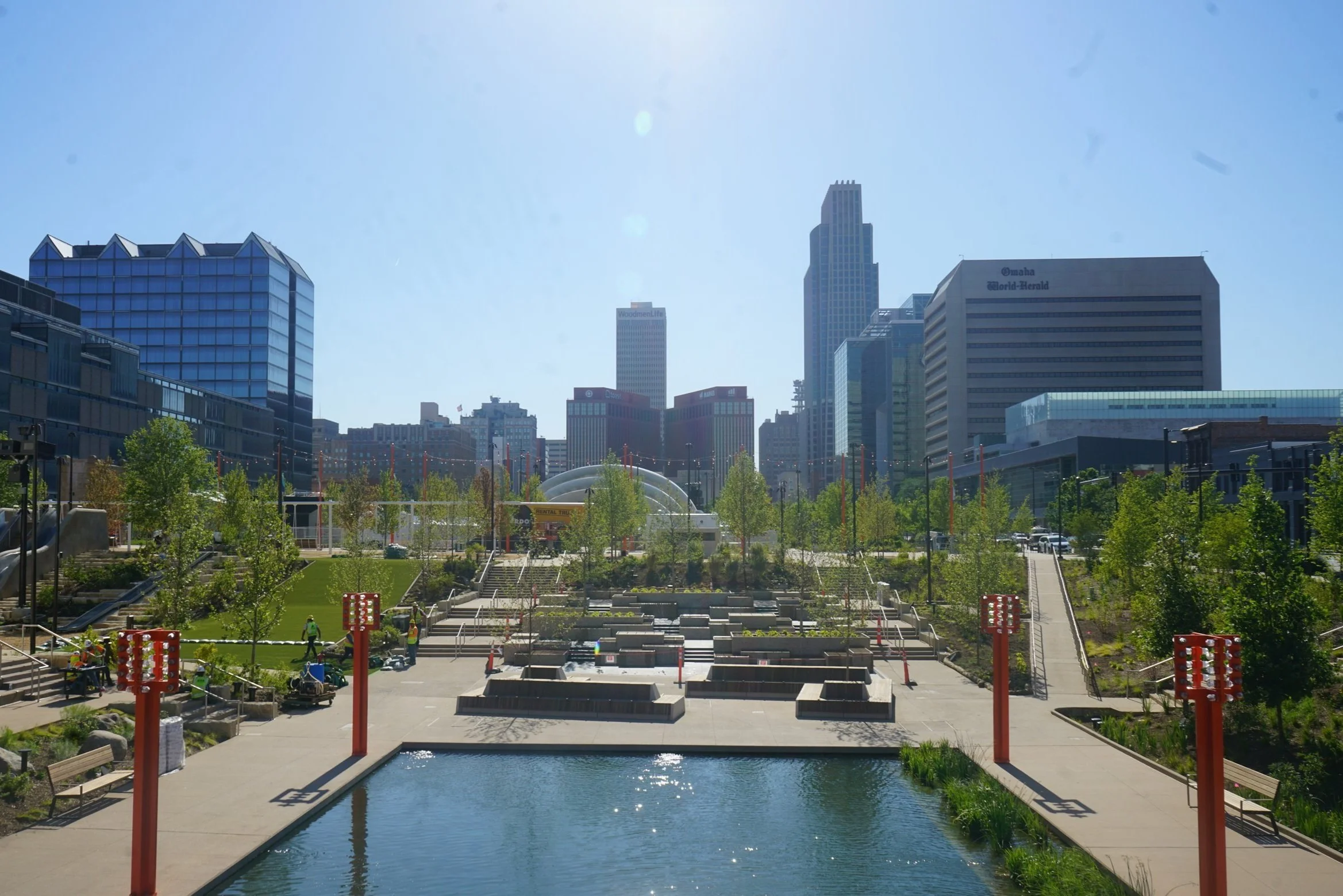$25 Million Bluestem Prairie Residential Pocket Ready to Sprout in North Omaha
‘Affordable homeownership’ for 85 families, says developer Habitat for Humanity of Omaha
Bluestem Prairie neighborhood near 52nd Street and Sorensen Parkway. Photo courtesy of Straightline Design
BY CINDY GONZALEZ, Nebraska Examiner
Editor’s note: This story has been updated to include details from the groundbreaking, including remarks from Spencer Danner, who grew up at the site.
A new $25 million neighborhood aimed at providing affordable homeownership opportunities is ready to sprout on a long-vacant North Omaha site once occupied by the neglected Wintergreen Apartments.
The previous rental complex was built under a different name in 1975 near 52nd Street and Sorensen Parkway. Those units were condemned and eventually demolished in 2006.
Bird’s eye view of area, in 2021, now being transformed to Bluestem Prairie. Photo courtesy of Habitat for Humanity Omaha
Now, after sitting 16 years as an eyesore, the roughly 15 acres is to be transformed into the Bluestem Prairie neighborhood.
Leading the project — whose official groundbreaking was Monday — is nonprofit Habitat for Humanity Omaha. The project is scheduled to be completed in 2025.
“We’re super excited,” said spokeswoman Tracie McPherson. “This is a development like no other that Habitat for Humanity Omaha has done before.”
Fond memories faded with disrepair
Working closely with the City of Omaha, Habitat acquired the property for $1 from the city.
The overall price tag includes home construction, a community park and infrastructure. Streets must be built and reconfigured; sewers and power will be installed.
Habitat says the bulk of the funding is to be paid by donors and the Nebraska Affordable Housing Trust Fund.
Bluestem Prairie neighborhood near 52nd Street and Sorensen Parkway. Photo courtesy of Straightline Design
In addition, city officials approved tax-increment financing of $3.4 million. TIF is a tool created by the Nebraska Legislature to assist in economic development.
Under the public subsidy program, property tax revenue generated by new development goes to help pay eligible costs incurred by the developer. After the TIF payment period, typically 20 years, the property tax revenue starts to flow to traditional recipients such as public schools and city government.
‘Mighty things’
Monday’s event, held as construction vehicles worked in the background, drew a few dozen business, community and other officials, including Habitat CEO Amanda Brewer, Mayor Jean Stothert, State Sen. Justin Wayne of North Omaha, State Sen. Tony Vargas of South Omaha, and Spencer Danner, a First National Bank vice president who lived at the site as a youth.
“When we work together as a team, we can do mighty things”
Juanita Johnson, City Councilwoman representing North Omaha, speaks at Bluestem groundbreaking. Photo credit: Cindy Gonzalez/Nebraska Examiner
City Councilwoman Juanita Johnson, another speaker, reflected on the area’s past, which included fond memories but also crime and social ills as the apartments fell into disrepair.
She said she is reassured knowing what is to come.
“When we work together as a team, we can do mighty things,” Johnson said.
The residential Bluestem Prairie pocket is designed to draw families of various generations, sizes, composition and incomes.
Home styles are to include about 20 easy-to-access villas that target empty nesters. “We’ve never done that before,” McPherson said.
‘Mother-in-law’ accessory quarters
Houses will contain up to five bedrooms for bigger families. Some will come with accessory units, often called mother-in-law quarters, McPherson said, allowing independent yet elderly relatives to “age in place” with family.
In addition to the 85 Bluestem homes, 15 other dwellings are to be rehabilitated on a nearby area spanning about four acres, McPherson said. While not technically part of Bluestem, the homes will be in close proximity.
A highlight of the Bluestem project, officials agree, is homeownership opportunities to be afforded to people who lack access to traditional housing and lending markets.
Buyers must have a two-year employment track record, have a certain amount of savings and earn less than 80% of the area’s median income, said Habitat program director Lacey Studnicka.
Graphic courtesy of Habitat for Humanity Omaha
Affordable homes ‘never as important’
Programs are available to help bridge affordability and down-payment gaps.
Habitat in general aims to provide creative ways to remove barriers to homeownership, Studnicka said. Residents also participate in training initiatives, for example, to help build up credit scores and savings accounts.
Today, Studnicka said, many Nebraskans pay rent way beyond the desired 30% or less of monthly household income.
Habitat officials pointed to a recent report involving multiple local organizations that said the Omaha metro area was short nearly 80,000 affordable housing units. It said that gap could increase to more than 100,000 over the next 20 years without significant intervention.
“The need for affordable home ownership has never been as important,” Studnicka said.
‘No Outlet’
A “No Outlet” sign still marks the entrance of the old Wintergreen apartments site — rekindling the sense of hopelessness that Spencer Danner equates with the complex he grew up in as a kid.
Now 44 years old and a bank executive, Danner said there were plenty of fond memories early on, as many of his friends and family members also lived at what was built in the mid-1970s as Myott Park.
In its heyday, he said, many viewed the project as an “architectural marvel.”
Kids used ingenuity and resources to have fun, sliding down wooden staircases on top of mattresses and playing hide-and-seek between dwellings.
Spencer Danner, of First National Bank of Omaha, spent part of his youth at an apartment site being transformed for homeownership opportunities. Photo credit: Cindy Gonzalez/Nebraska Examiner
But fond memories turned darker as landlords neglected the campus and crime creeped in, Danner said. Sometimes, he recalled, the entire bowl was pitch black.
“It was a scary place at times,” he said. “Unsafe.”
Upon revisiting the neighborhood some six years ago, Danner said he felt a resurgence of anxiety. That’s being pushed aside now, he said, with a growing sense of anticipation of what’s next.
On Monday, Danner was among a small crowd celebrating the groundbreaking of the $25 million Bluestem Prairie neighborhood, which is poised to rise on the 15 acres once occupied by Myott Park, later renamed Wintergreen.
During an interview, Danner pointed out the “No Outlet” sign, which is intended to warn visitors and motorists that the street leading to the housing site has no other way out.
Danner said it was somewhat symbolic of the hopelessness that grew in the neighborhood.
But today, he said, he is excited to see the rebirth of the site not as rental units, but as 85 homes for families seeking to build generational wealth as homeowners. Roads are to be reconfigured, entrances and street lights added.
“We all say, ‘It’s about time,’” Danner told those who gathered, adding that he said he felt like he was winning an award. Before joining First National Bank of Omaha, Danner was the city’s director of human rights and economic inclusion.
Construction equipment roared behind him, as workers prepared the site for homebuilding.
“This is beautiful,” Danner said. “It’s a blessing.”




















